University Assignment: Social Science Questions on Research and Ethics
VerifiedAdded on 2022/12/30
|9
|2573
|38
Homework Assignment
AI Summary
This assignment addresses three key social science questions. The first question explores the rationale behind the NHMRC guidelines for conducting ethical research, emphasizing the importance of protecting human participants and promoting responsible research practices. It highlights the role of the NHMRC in setting standards and ensuring ethical review processes. The second question examines the types of social research questions best suited for quantitative methods, such as comparative, descriptive, and relationship-based questions, and explains why these methods are effective for generating numerical data and identifying patterns. The assignment also discusses the benefits of quantitative research in this context. The third question analyzes the statement that statistics are objective indicators essential to the process of policy making, arguing that statistics provide evidence-based insights for informed decision-making across various fields, including banking, mathematics, and state administration. It underscores the importance of timely, relevant, and accurate statistical data in shaping effective policies and improving societal outcomes.
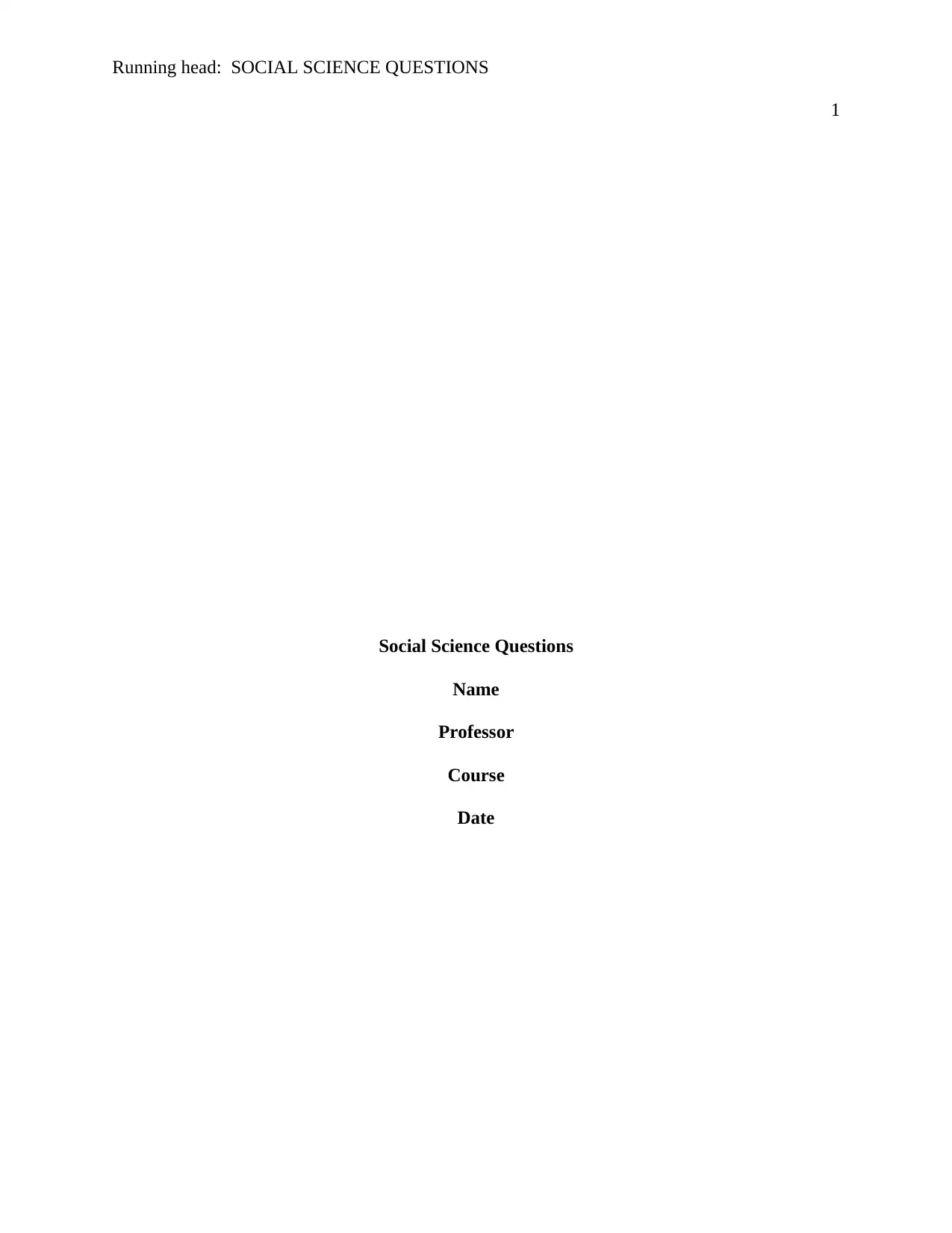
Running head: SOCIAL SCIENCE QUESTIONS
1
Social Science Questions
Name
Professor
Course
Date
1
Social Science Questions
Name
Professor
Course
Date
Paraphrase This Document
Need a fresh take? Get an instant paraphrase of this document with our AI Paraphraser
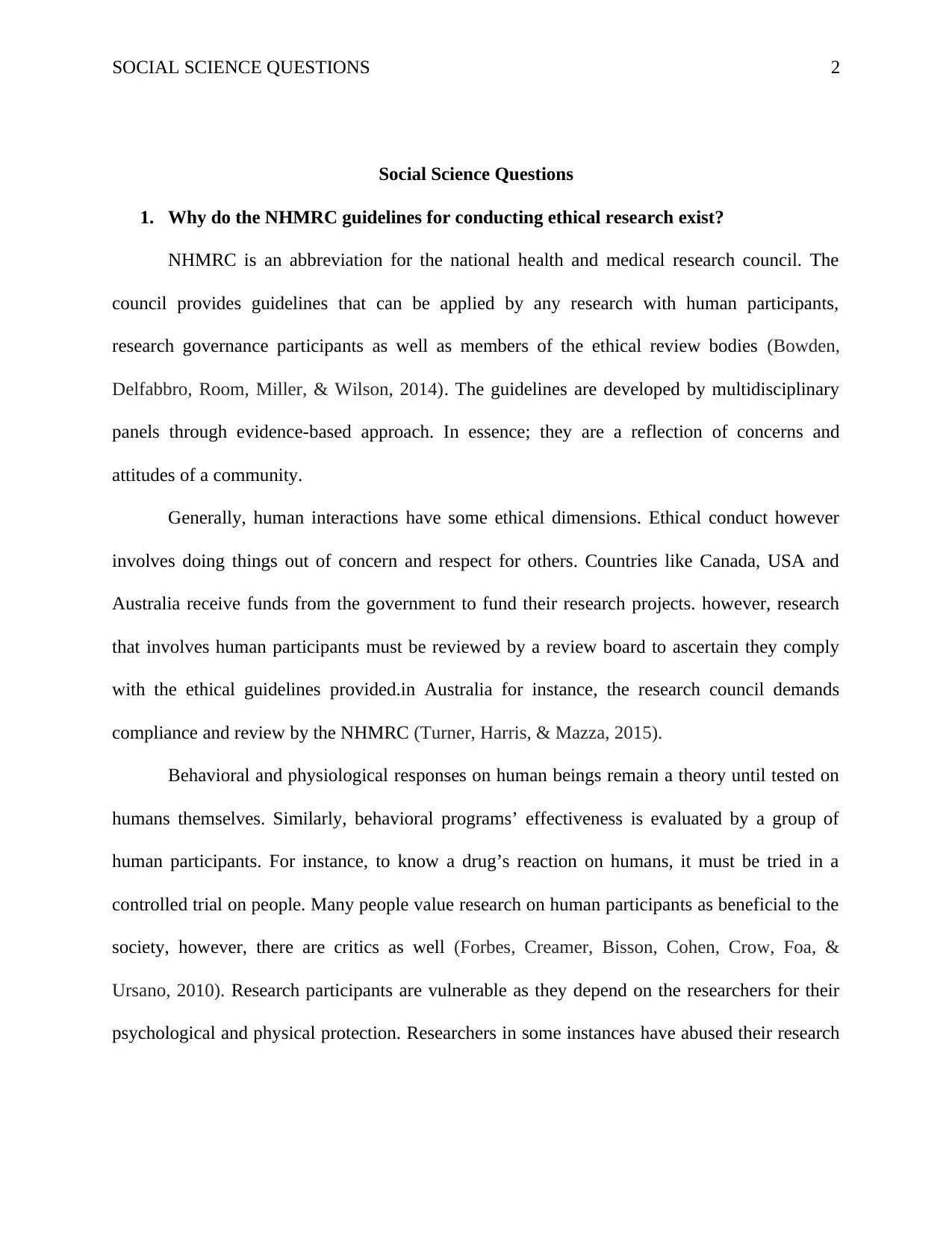
SOCIAL SCIENCE QUESTIONS 2
Social Science Questions
1. Why do the NHMRC guidelines for conducting ethical research exist?
NHMRC is an abbreviation for the national health and medical research council. The
council provides guidelines that can be applied by any research with human participants,
research governance participants as well as members of the ethical review bodies (Bowden,
Delfabbro, Room, Miller, & Wilson, 2014). The guidelines are developed by multidisciplinary
panels through evidence-based approach. In essence; they are a reflection of concerns and
attitudes of a community.
Generally, human interactions have some ethical dimensions. Ethical conduct however
involves doing things out of concern and respect for others. Countries like Canada, USA and
Australia receive funds from the government to fund their research projects. however, research
that involves human participants must be reviewed by a review board to ascertain they comply
with the ethical guidelines provided.in Australia for instance, the research council demands
compliance and review by the NHMRC (Turner, Harris, & Mazza, 2015).
Behavioral and physiological responses on human beings remain a theory until tested on
humans themselves. Similarly, behavioral programs’ effectiveness is evaluated by a group of
human participants. For instance, to know a drug’s reaction on humans, it must be tried in a
controlled trial on people. Many people value research on human participants as beneficial to the
society, however, there are critics as well (Forbes, Creamer, Bisson, Cohen, Crow, Foa, &
Ursano, 2010). Research participants are vulnerable as they depend on the researchers for their
psychological and physical protection. Researchers in some instances have abused their research
Social Science Questions
1. Why do the NHMRC guidelines for conducting ethical research exist?
NHMRC is an abbreviation for the national health and medical research council. The
council provides guidelines that can be applied by any research with human participants,
research governance participants as well as members of the ethical review bodies (Bowden,
Delfabbro, Room, Miller, & Wilson, 2014). The guidelines are developed by multidisciplinary
panels through evidence-based approach. In essence; they are a reflection of concerns and
attitudes of a community.
Generally, human interactions have some ethical dimensions. Ethical conduct however
involves doing things out of concern and respect for others. Countries like Canada, USA and
Australia receive funds from the government to fund their research projects. however, research
that involves human participants must be reviewed by a review board to ascertain they comply
with the ethical guidelines provided.in Australia for instance, the research council demands
compliance and review by the NHMRC (Turner, Harris, & Mazza, 2015).
Behavioral and physiological responses on human beings remain a theory until tested on
humans themselves. Similarly, behavioral programs’ effectiveness is evaluated by a group of
human participants. For instance, to know a drug’s reaction on humans, it must be tried in a
controlled trial on people. Many people value research on human participants as beneficial to the
society, however, there are critics as well (Forbes, Creamer, Bisson, Cohen, Crow, Foa, &
Ursano, 2010). Research participants are vulnerable as they depend on the researchers for their
psychological and physical protection. Researchers in some instances have abused their research
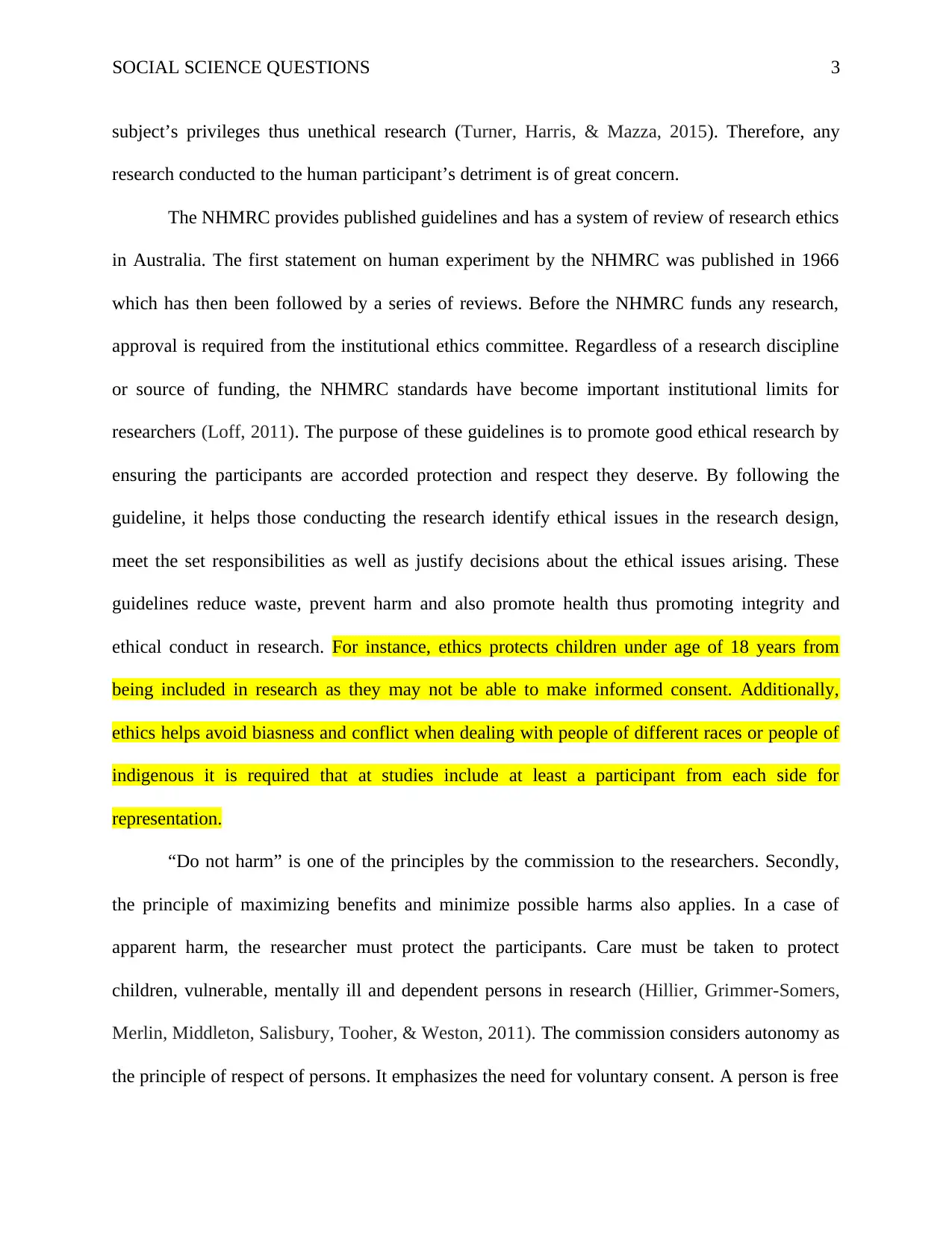
SOCIAL SCIENCE QUESTIONS 3
subject’s privileges thus unethical research (Turner, Harris, & Mazza, 2015). Therefore, any
research conducted to the human participant’s detriment is of great concern.
The NHMRC provides published guidelines and has a system of review of research ethics
in Australia. The first statement on human experiment by the NHMRC was published in 1966
which has then been followed by a series of reviews. Before the NHMRC funds any research,
approval is required from the institutional ethics committee. Regardless of a research discipline
or source of funding, the NHMRC standards have become important institutional limits for
researchers (Loff, 2011). The purpose of these guidelines is to promote good ethical research by
ensuring the participants are accorded protection and respect they deserve. By following the
guideline, it helps those conducting the research identify ethical issues in the research design,
meet the set responsibilities as well as justify decisions about the ethical issues arising. These
guidelines reduce waste, prevent harm and also promote health thus promoting integrity and
ethical conduct in research. For instance, ethics protects children under age of 18 years from
being included in research as they may not be able to make informed consent. Additionally,
ethics helps avoid biasness and conflict when dealing with people of different races or people of
indigenous it is required that at studies include at least a participant from each side for
representation.
“Do not harm” is one of the principles by the commission to the researchers. Secondly,
the principle of maximizing benefits and minimize possible harms also applies. In a case of
apparent harm, the researcher must protect the participants. Care must be taken to protect
children, vulnerable, mentally ill and dependent persons in research (Hillier, Grimmer-Somers,
Merlin, Middleton, Salisbury, Tooher, & Weston, 2011). The commission considers autonomy as
the principle of respect of persons. It emphasizes the need for voluntary consent. A person is free
subject’s privileges thus unethical research (Turner, Harris, & Mazza, 2015). Therefore, any
research conducted to the human participant’s detriment is of great concern.
The NHMRC provides published guidelines and has a system of review of research ethics
in Australia. The first statement on human experiment by the NHMRC was published in 1966
which has then been followed by a series of reviews. Before the NHMRC funds any research,
approval is required from the institutional ethics committee. Regardless of a research discipline
or source of funding, the NHMRC standards have become important institutional limits for
researchers (Loff, 2011). The purpose of these guidelines is to promote good ethical research by
ensuring the participants are accorded protection and respect they deserve. By following the
guideline, it helps those conducting the research identify ethical issues in the research design,
meet the set responsibilities as well as justify decisions about the ethical issues arising. These
guidelines reduce waste, prevent harm and also promote health thus promoting integrity and
ethical conduct in research. For instance, ethics protects children under age of 18 years from
being included in research as they may not be able to make informed consent. Additionally,
ethics helps avoid biasness and conflict when dealing with people of different races or people of
indigenous it is required that at studies include at least a participant from each side for
representation.
“Do not harm” is one of the principles by the commission to the researchers. Secondly,
the principle of maximizing benefits and minimize possible harms also applies. In a case of
apparent harm, the researcher must protect the participants. Care must be taken to protect
children, vulnerable, mentally ill and dependent persons in research (Hillier, Grimmer-Somers,
Merlin, Middleton, Salisbury, Tooher, & Weston, 2011). The commission considers autonomy as
the principle of respect of persons. It emphasizes the need for voluntary consent. A person is free
⊘ This is a preview!⊘
Do you want full access?
Subscribe today to unlock all pages.

Trusted by 1+ million students worldwide
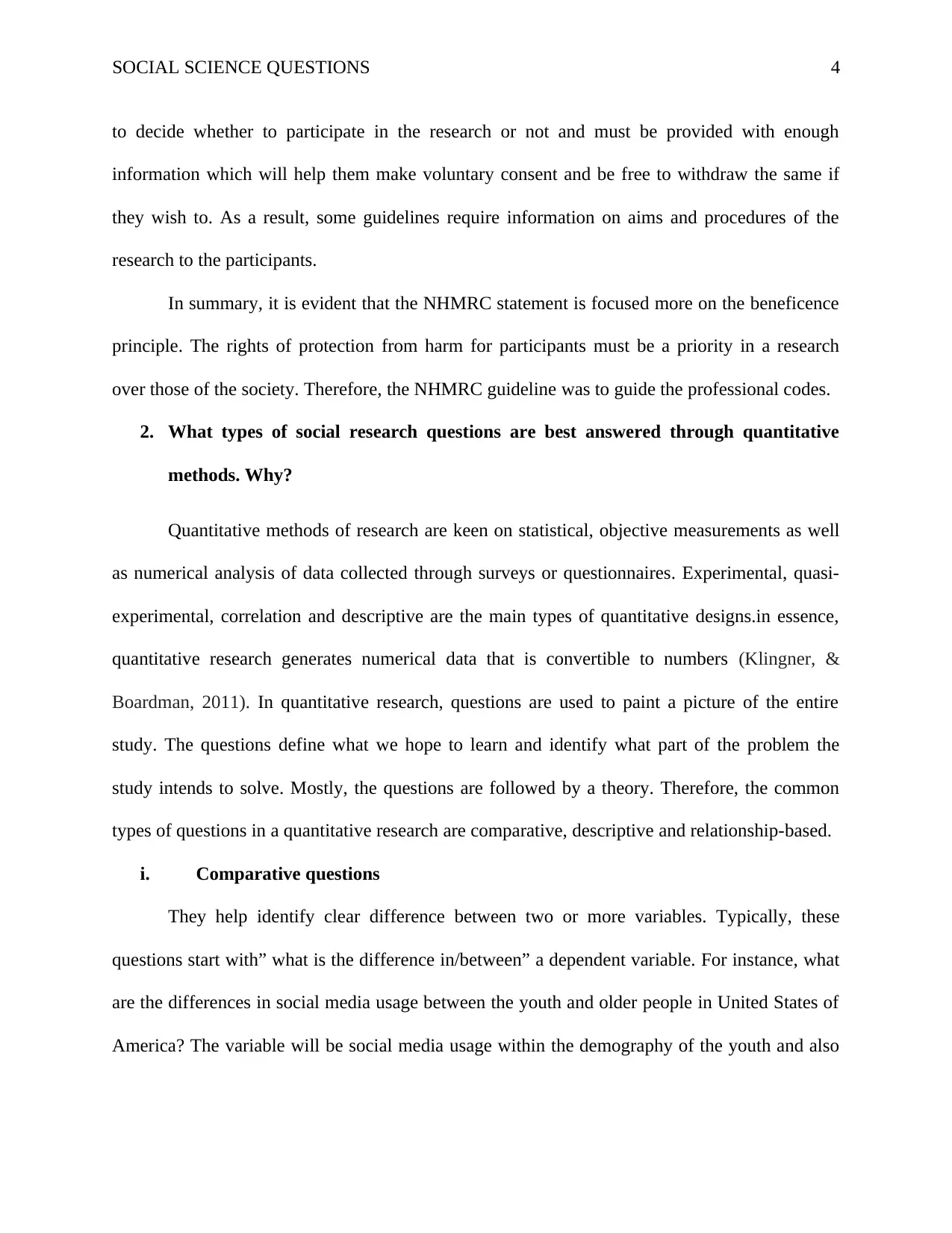
SOCIAL SCIENCE QUESTIONS 4
to decide whether to participate in the research or not and must be provided with enough
information which will help them make voluntary consent and be free to withdraw the same if
they wish to. As a result, some guidelines require information on aims and procedures of the
research to the participants.
In summary, it is evident that the NHMRC statement is focused more on the beneficence
principle. The rights of protection from harm for participants must be a priority in a research
over those of the society. Therefore, the NHMRC guideline was to guide the professional codes.
2. What types of social research questions are best answered through quantitative
methods. Why?
Quantitative methods of research are keen on statistical, objective measurements as well
as numerical analysis of data collected through surveys or questionnaires. Experimental, quasi-
experimental, correlation and descriptive are the main types of quantitative designs.in essence,
quantitative research generates numerical data that is convertible to numbers (Klingner, &
Boardman, 2011). In quantitative research, questions are used to paint a picture of the entire
study. The questions define what we hope to learn and identify what part of the problem the
study intends to solve. Mostly, the questions are followed by a theory. Therefore, the common
types of questions in a quantitative research are comparative, descriptive and relationship-based.
i. Comparative questions
They help identify clear difference between two or more variables. Typically, these
questions start with” what is the difference in/between” a dependent variable. For instance, what
are the differences in social media usage between the youth and older people in United States of
America? The variable will be social media usage within the demography of the youth and also
to decide whether to participate in the research or not and must be provided with enough
information which will help them make voluntary consent and be free to withdraw the same if
they wish to. As a result, some guidelines require information on aims and procedures of the
research to the participants.
In summary, it is evident that the NHMRC statement is focused more on the beneficence
principle. The rights of protection from harm for participants must be a priority in a research
over those of the society. Therefore, the NHMRC guideline was to guide the professional codes.
2. What types of social research questions are best answered through quantitative
methods. Why?
Quantitative methods of research are keen on statistical, objective measurements as well
as numerical analysis of data collected through surveys or questionnaires. Experimental, quasi-
experimental, correlation and descriptive are the main types of quantitative designs.in essence,
quantitative research generates numerical data that is convertible to numbers (Klingner, &
Boardman, 2011). In quantitative research, questions are used to paint a picture of the entire
study. The questions define what we hope to learn and identify what part of the problem the
study intends to solve. Mostly, the questions are followed by a theory. Therefore, the common
types of questions in a quantitative research are comparative, descriptive and relationship-based.
i. Comparative questions
They help identify clear difference between two or more variables. Typically, these
questions start with” what is the difference in/between” a dependent variable. For instance, what
are the differences in social media usage between the youth and older people in United States of
America? The variable will be social media usage within the demography of the youth and also
Paraphrase This Document
Need a fresh take? Get an instant paraphrase of this document with our AI Paraphraser
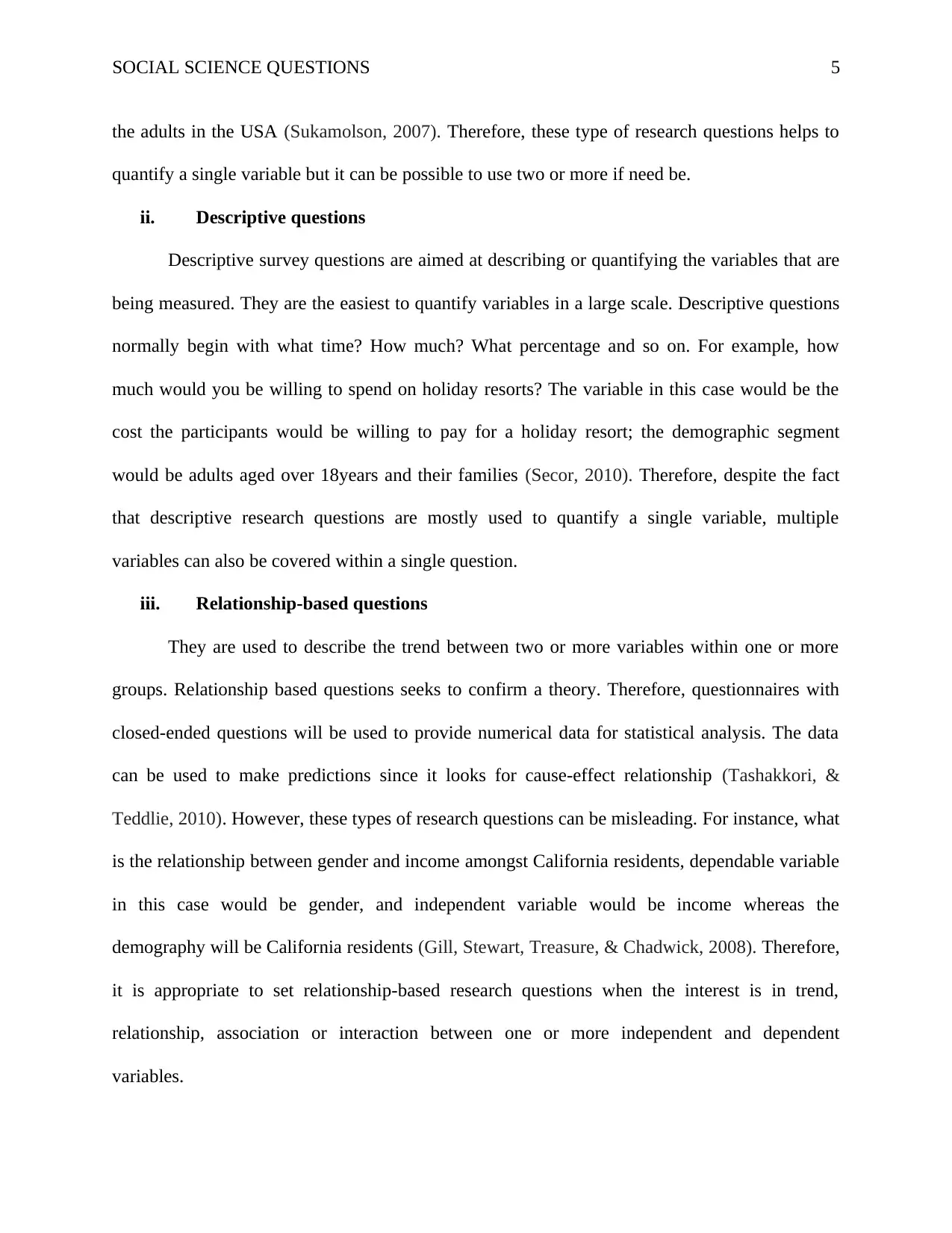
SOCIAL SCIENCE QUESTIONS 5
the adults in the USA (Sukamolson, 2007). Therefore, these type of research questions helps to
quantify a single variable but it can be possible to use two or more if need be.
ii. Descriptive questions
Descriptive survey questions are aimed at describing or quantifying the variables that are
being measured. They are the easiest to quantify variables in a large scale. Descriptive questions
normally begin with what time? How much? What percentage and so on. For example, how
much would you be willing to spend on holiday resorts? The variable in this case would be the
cost the participants would be willing to pay for a holiday resort; the demographic segment
would be adults aged over 18years and their families (Secor, 2010). Therefore, despite the fact
that descriptive research questions are mostly used to quantify a single variable, multiple
variables can also be covered within a single question.
iii. Relationship-based questions
They are used to describe the trend between two or more variables within one or more
groups. Relationship based questions seeks to confirm a theory. Therefore, questionnaires with
closed-ended questions will be used to provide numerical data for statistical analysis. The data
can be used to make predictions since it looks for cause-effect relationship (Tashakkori, &
Teddlie, 2010). However, these types of research questions can be misleading. For instance, what
is the relationship between gender and income amongst California residents, dependable variable
in this case would be gender, and independent variable would be income whereas the
demography will be California residents (Gill, Stewart, Treasure, & Chadwick, 2008). Therefore,
it is appropriate to set relationship-based research questions when the interest is in trend,
relationship, association or interaction between one or more independent and dependent
variables.
the adults in the USA (Sukamolson, 2007). Therefore, these type of research questions helps to
quantify a single variable but it can be possible to use two or more if need be.
ii. Descriptive questions
Descriptive survey questions are aimed at describing or quantifying the variables that are
being measured. They are the easiest to quantify variables in a large scale. Descriptive questions
normally begin with what time? How much? What percentage and so on. For example, how
much would you be willing to spend on holiday resorts? The variable in this case would be the
cost the participants would be willing to pay for a holiday resort; the demographic segment
would be adults aged over 18years and their families (Secor, 2010). Therefore, despite the fact
that descriptive research questions are mostly used to quantify a single variable, multiple
variables can also be covered within a single question.
iii. Relationship-based questions
They are used to describe the trend between two or more variables within one or more
groups. Relationship based questions seeks to confirm a theory. Therefore, questionnaires with
closed-ended questions will be used to provide numerical data for statistical analysis. The data
can be used to make predictions since it looks for cause-effect relationship (Tashakkori, &
Teddlie, 2010). However, these types of research questions can be misleading. For instance, what
is the relationship between gender and income amongst California residents, dependable variable
in this case would be gender, and independent variable would be income whereas the
demography will be California residents (Gill, Stewart, Treasure, & Chadwick, 2008). Therefore,
it is appropriate to set relationship-based research questions when the interest is in trend,
relationship, association or interaction between one or more independent and dependent
variables.
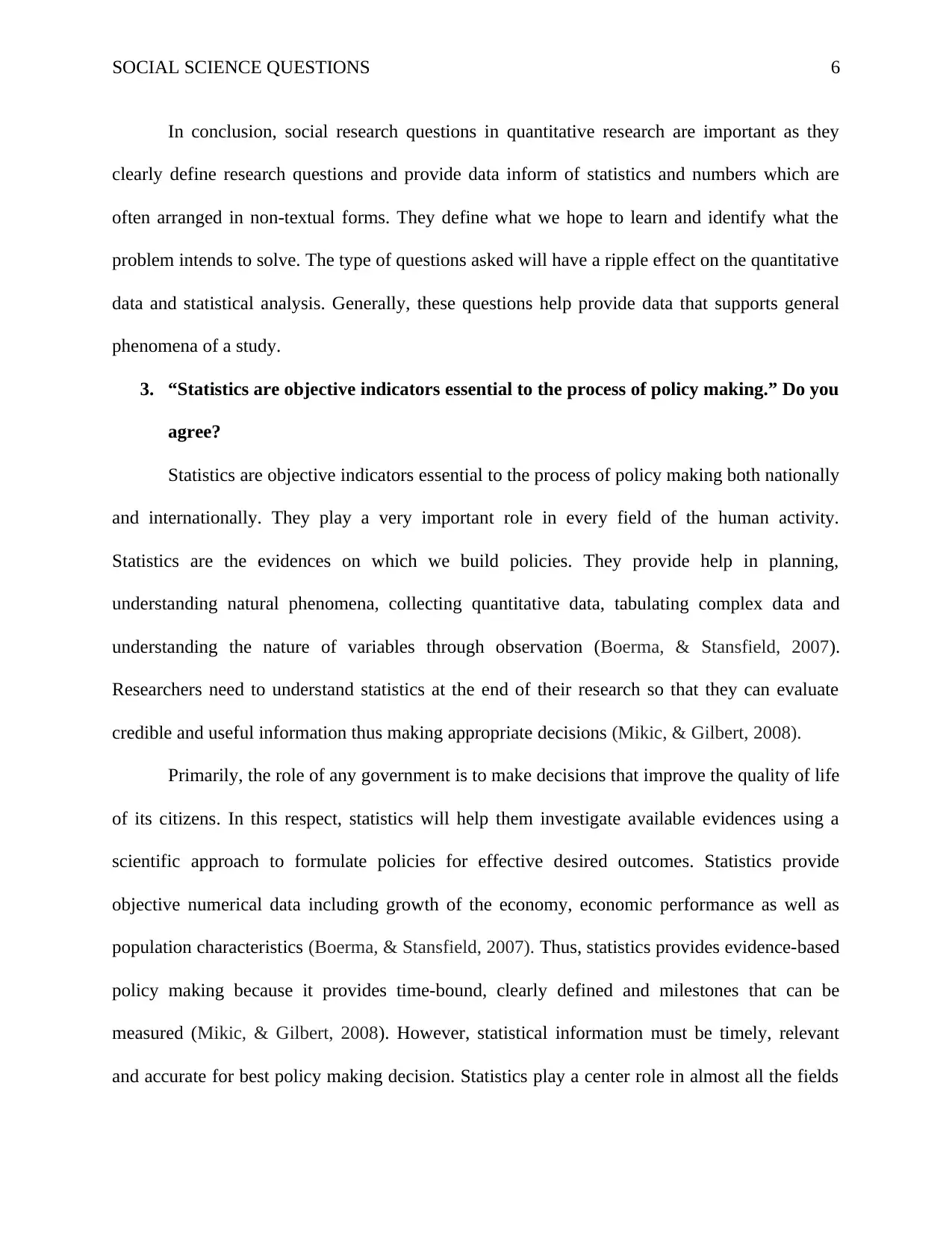
SOCIAL SCIENCE QUESTIONS 6
In conclusion, social research questions in quantitative research are important as they
clearly define research questions and provide data inform of statistics and numbers which are
often arranged in non-textual forms. They define what we hope to learn and identify what the
problem intends to solve. The type of questions asked will have a ripple effect on the quantitative
data and statistical analysis. Generally, these questions help provide data that supports general
phenomena of a study.
3. “Statistics are objective indicators essential to the process of policy making.” Do you
agree?
Statistics are objective indicators essential to the process of policy making both nationally
and internationally. They play a very important role in every field of the human activity.
Statistics are the evidences on which we build policies. They provide help in planning,
understanding natural phenomena, collecting quantitative data, tabulating complex data and
understanding the nature of variables through observation (Boerma, & Stansfield, 2007).
Researchers need to understand statistics at the end of their research so that they can evaluate
credible and useful information thus making appropriate decisions (Mikic, & Gilbert, 2008).
Primarily, the role of any government is to make decisions that improve the quality of life
of its citizens. In this respect, statistics will help them investigate available evidences using a
scientific approach to formulate policies for effective desired outcomes. Statistics provide
objective numerical data including growth of the economy, economic performance as well as
population characteristics (Boerma, & Stansfield, 2007). Thus, statistics provides evidence-based
policy making because it provides time-bound, clearly defined and milestones that can be
measured (Mikic, & Gilbert, 2008). However, statistical information must be timely, relevant
and accurate for best policy making decision. Statistics play a center role in almost all the fields
In conclusion, social research questions in quantitative research are important as they
clearly define research questions and provide data inform of statistics and numbers which are
often arranged in non-textual forms. They define what we hope to learn and identify what the
problem intends to solve. The type of questions asked will have a ripple effect on the quantitative
data and statistical analysis. Generally, these questions help provide data that supports general
phenomena of a study.
3. “Statistics are objective indicators essential to the process of policy making.” Do you
agree?
Statistics are objective indicators essential to the process of policy making both nationally
and internationally. They play a very important role in every field of the human activity.
Statistics are the evidences on which we build policies. They provide help in planning,
understanding natural phenomena, collecting quantitative data, tabulating complex data and
understanding the nature of variables through observation (Boerma, & Stansfield, 2007).
Researchers need to understand statistics at the end of their research so that they can evaluate
credible and useful information thus making appropriate decisions (Mikic, & Gilbert, 2008).
Primarily, the role of any government is to make decisions that improve the quality of life
of its citizens. In this respect, statistics will help them investigate available evidences using a
scientific approach to formulate policies for effective desired outcomes. Statistics provide
objective numerical data including growth of the economy, economic performance as well as
population characteristics (Boerma, & Stansfield, 2007). Thus, statistics provides evidence-based
policy making because it provides time-bound, clearly defined and milestones that can be
measured (Mikic, & Gilbert, 2008). However, statistical information must be timely, relevant
and accurate for best policy making decision. Statistics play a center role in almost all the fields
⊘ This is a preview!⊘
Do you want full access?
Subscribe today to unlock all pages.

Trusted by 1+ million students worldwide
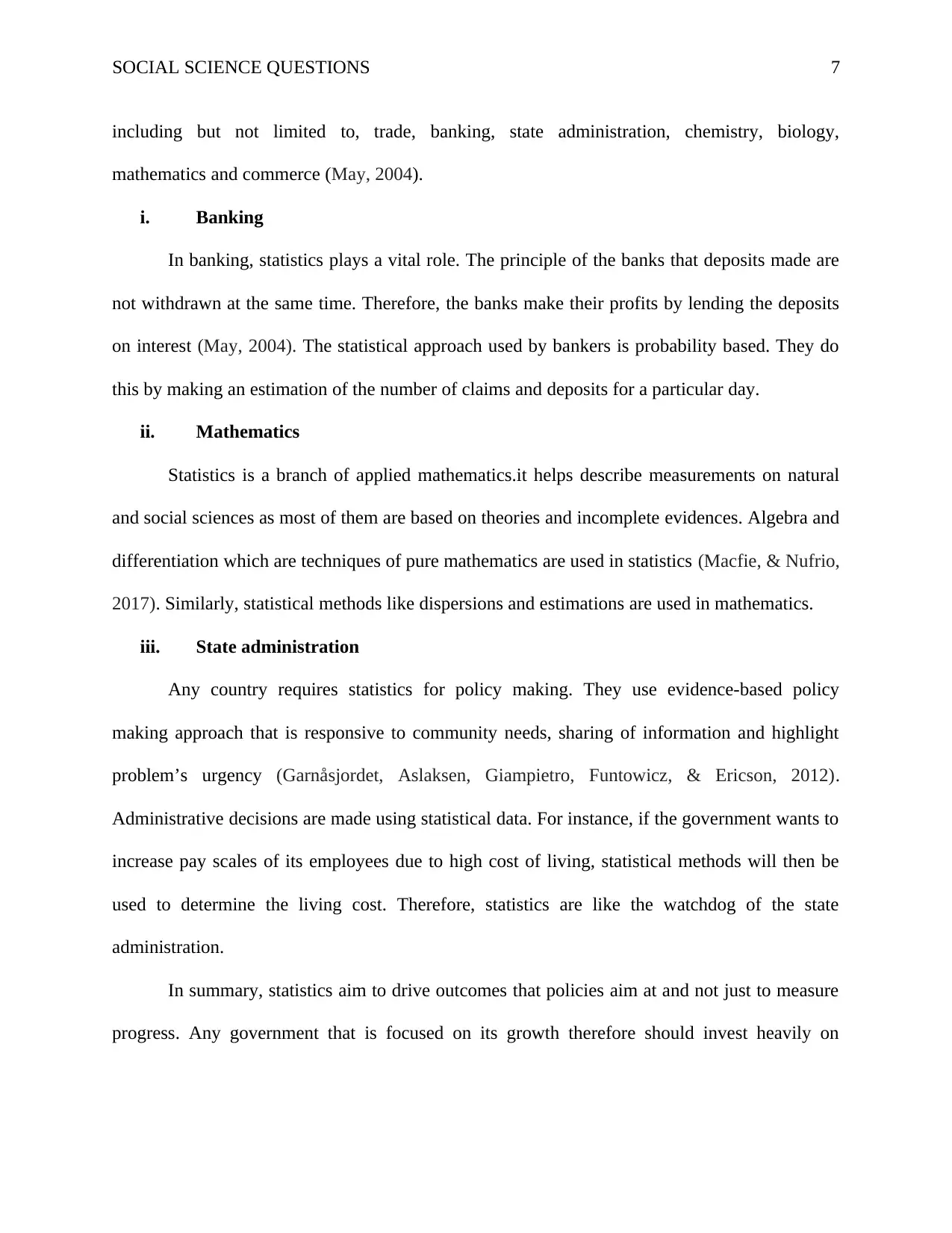
SOCIAL SCIENCE QUESTIONS 7
including but not limited to, trade, banking, state administration, chemistry, biology,
mathematics and commerce (May, 2004).
i. Banking
In banking, statistics plays a vital role. The principle of the banks that deposits made are
not withdrawn at the same time. Therefore, the banks make their profits by lending the deposits
on interest (May, 2004). The statistical approach used by bankers is probability based. They do
this by making an estimation of the number of claims and deposits for a particular day.
ii. Mathematics
Statistics is a branch of applied mathematics.it helps describe measurements on natural
and social sciences as most of them are based on theories and incomplete evidences. Algebra and
differentiation which are techniques of pure mathematics are used in statistics (Macfie, & Nufrio,
2017). Similarly, statistical methods like dispersions and estimations are used in mathematics.
iii. State administration
Any country requires statistics for policy making. They use evidence-based policy
making approach that is responsive to community needs, sharing of information and highlight
problem’s urgency (Garnåsjordet, Aslaksen, Giampietro, Funtowicz, & Ericson, 2012).
Administrative decisions are made using statistical data. For instance, if the government wants to
increase pay scales of its employees due to high cost of living, statistical methods will then be
used to determine the living cost. Therefore, statistics are like the watchdog of the state
administration.
In summary, statistics aim to drive outcomes that policies aim at and not just to measure
progress. Any government that is focused on its growth therefore should invest heavily on
including but not limited to, trade, banking, state administration, chemistry, biology,
mathematics and commerce (May, 2004).
i. Banking
In banking, statistics plays a vital role. The principle of the banks that deposits made are
not withdrawn at the same time. Therefore, the banks make their profits by lending the deposits
on interest (May, 2004). The statistical approach used by bankers is probability based. They do
this by making an estimation of the number of claims and deposits for a particular day.
ii. Mathematics
Statistics is a branch of applied mathematics.it helps describe measurements on natural
and social sciences as most of them are based on theories and incomplete evidences. Algebra and
differentiation which are techniques of pure mathematics are used in statistics (Macfie, & Nufrio,
2017). Similarly, statistical methods like dispersions and estimations are used in mathematics.
iii. State administration
Any country requires statistics for policy making. They use evidence-based policy
making approach that is responsive to community needs, sharing of information and highlight
problem’s urgency (Garnåsjordet, Aslaksen, Giampietro, Funtowicz, & Ericson, 2012).
Administrative decisions are made using statistical data. For instance, if the government wants to
increase pay scales of its employees due to high cost of living, statistical methods will then be
used to determine the living cost. Therefore, statistics are like the watchdog of the state
administration.
In summary, statistics aim to drive outcomes that policies aim at and not just to measure
progress. Any government that is focused on its growth therefore should invest heavily on
Paraphrase This Document
Need a fresh take? Get an instant paraphrase of this document with our AI Paraphraser
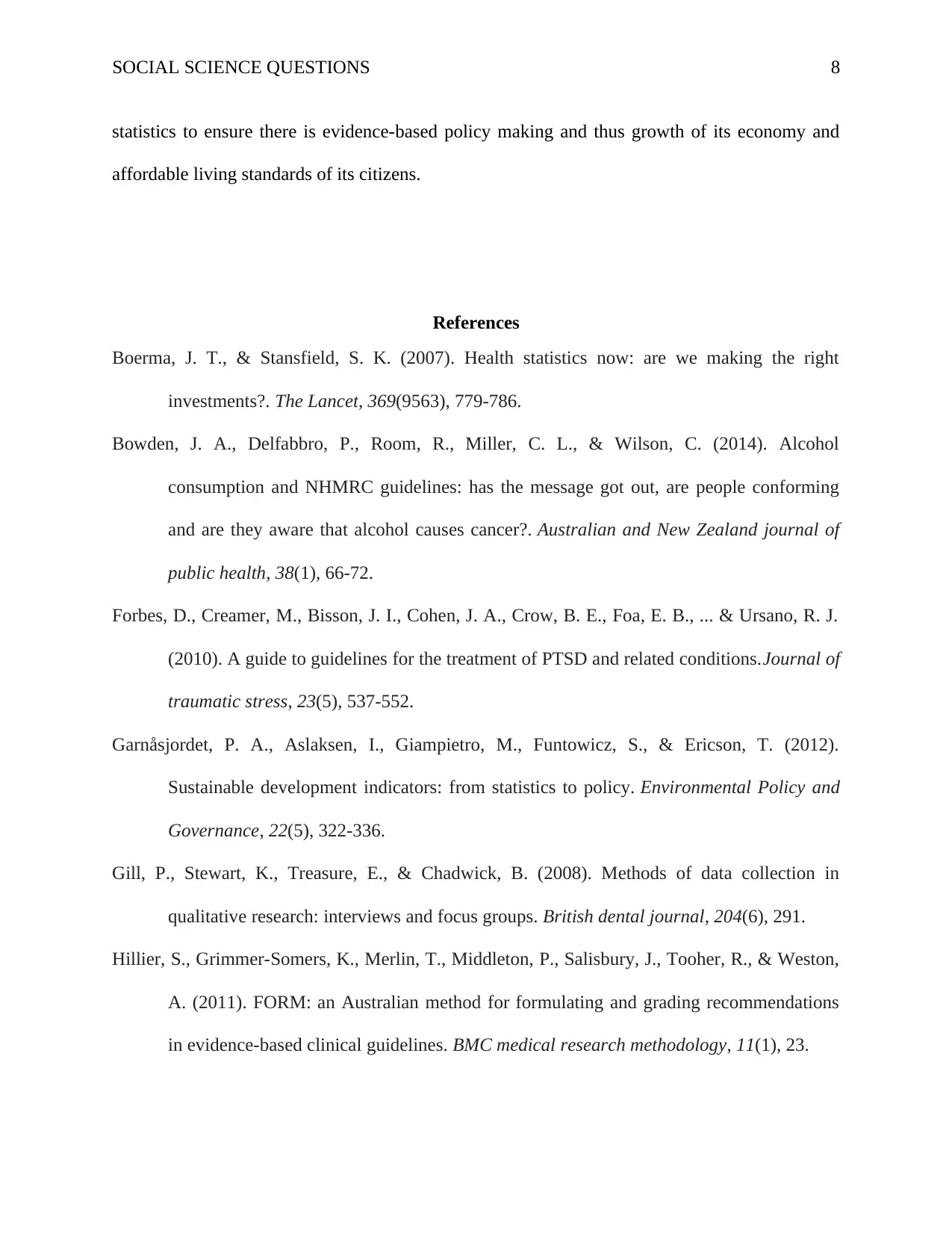
SOCIAL SCIENCE QUESTIONS 8
statistics to ensure there is evidence-based policy making and thus growth of its economy and
affordable living standards of its citizens.
References
Boerma, J. T., & Stansfield, S. K. (2007). Health statistics now: are we making the right
investments?. The Lancet, 369(9563), 779-786.
Bowden, J. A., Delfabbro, P., Room, R., Miller, C. L., & Wilson, C. (2014). Alcohol
consumption and NHMRC guidelines: has the message got out, are people conforming
and are they aware that alcohol causes cancer?. Australian and New Zealand journal of
public health, 38(1), 66-72.
Forbes, D., Creamer, M., Bisson, J. I., Cohen, J. A., Crow, B. E., Foa, E. B., ... & Ursano, R. J.
(2010). A guide to guidelines for the treatment of PTSD and related conditions.Journal of
traumatic stress, 23(5), 537-552.
Garnåsjordet, P. A., Aslaksen, I., Giampietro, M., Funtowicz, S., & Ericson, T. (2012).
Sustainable development indicators: from statistics to policy. Environmental Policy and
Governance, 22(5), 322-336.
Gill, P., Stewart, K., Treasure, E., & Chadwick, B. (2008). Methods of data collection in
qualitative research: interviews and focus groups. British dental journal, 204(6), 291.
Hillier, S., Grimmer-Somers, K., Merlin, T., Middleton, P., Salisbury, J., Tooher, R., & Weston,
A. (2011). FORM: an Australian method for formulating and grading recommendations
in evidence-based clinical guidelines. BMC medical research methodology, 11(1), 23.
statistics to ensure there is evidence-based policy making and thus growth of its economy and
affordable living standards of its citizens.
References
Boerma, J. T., & Stansfield, S. K. (2007). Health statistics now: are we making the right
investments?. The Lancet, 369(9563), 779-786.
Bowden, J. A., Delfabbro, P., Room, R., Miller, C. L., & Wilson, C. (2014). Alcohol
consumption and NHMRC guidelines: has the message got out, are people conforming
and are they aware that alcohol causes cancer?. Australian and New Zealand journal of
public health, 38(1), 66-72.
Forbes, D., Creamer, M., Bisson, J. I., Cohen, J. A., Crow, B. E., Foa, E. B., ... & Ursano, R. J.
(2010). A guide to guidelines for the treatment of PTSD and related conditions.Journal of
traumatic stress, 23(5), 537-552.
Garnåsjordet, P. A., Aslaksen, I., Giampietro, M., Funtowicz, S., & Ericson, T. (2012).
Sustainable development indicators: from statistics to policy. Environmental Policy and
Governance, 22(5), 322-336.
Gill, P., Stewart, K., Treasure, E., & Chadwick, B. (2008). Methods of data collection in
qualitative research: interviews and focus groups. British dental journal, 204(6), 291.
Hillier, S., Grimmer-Somers, K., Merlin, T., Middleton, P., Salisbury, J., Tooher, R., & Weston,
A. (2011). FORM: an Australian method for formulating and grading recommendations
in evidence-based clinical guidelines. BMC medical research methodology, 11(1), 23.
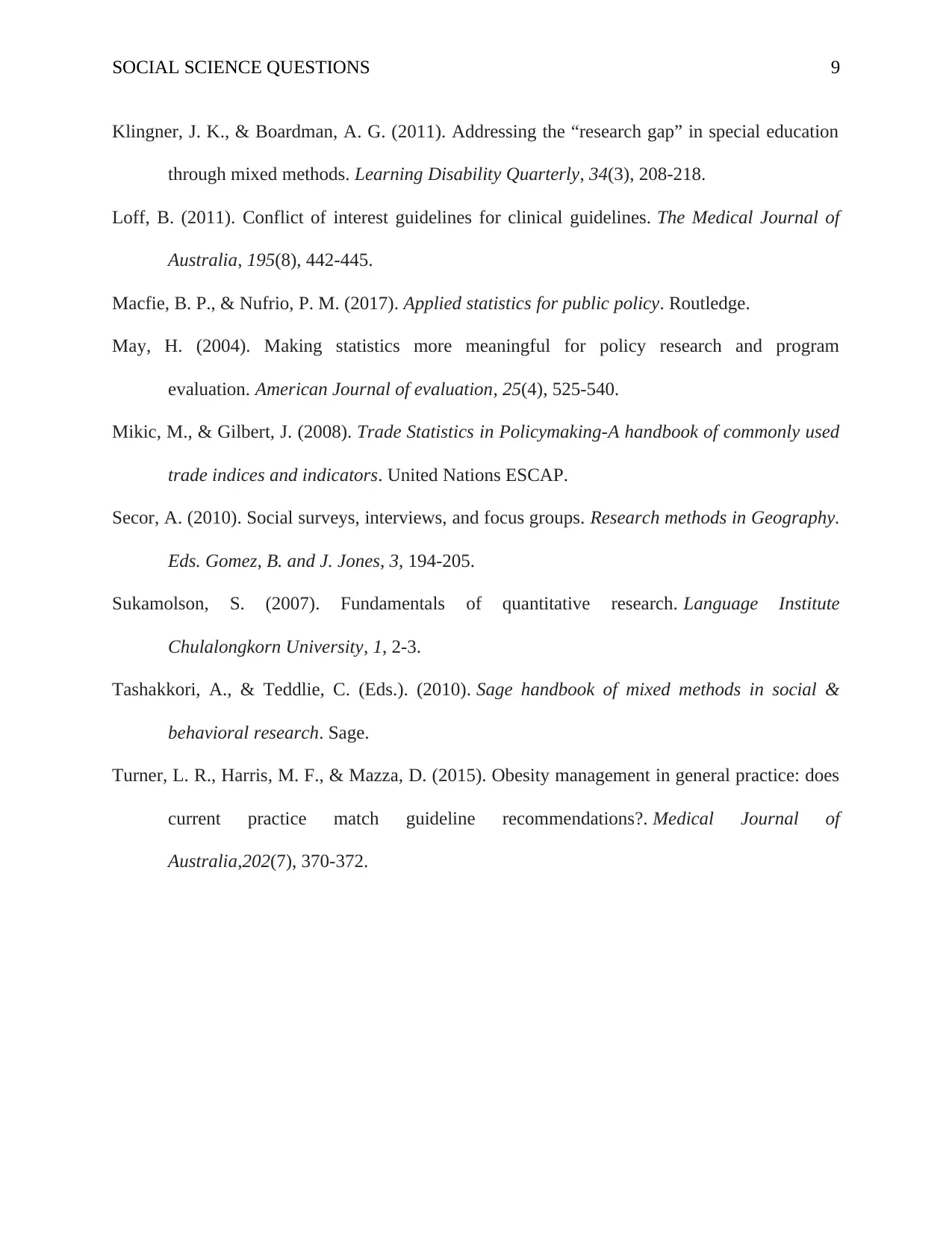
SOCIAL SCIENCE QUESTIONS 9
Klingner, J. K., & Boardman, A. G. (2011). Addressing the “research gap” in special education
through mixed methods. Learning Disability Quarterly, 34(3), 208-218.
Loff, B. (2011). Conflict of interest guidelines for clinical guidelines. The Medical Journal of
Australia, 195(8), 442-445.
Macfie, B. P., & Nufrio, P. M. (2017). Applied statistics for public policy. Routledge.
May, H. (2004). Making statistics more meaningful for policy research and program
evaluation. American Journal of evaluation, 25(4), 525-540.
Mikic, M., & Gilbert, J. (2008). Trade Statistics in Policymaking-A handbook of commonly used
trade indices and indicators. United Nations ESCAP.
Secor, A. (2010). Social surveys, interviews, and focus groups. Research methods in Geography.
Eds. Gomez, B. and J. Jones, 3, 194-205.
Sukamolson, S. (2007). Fundamentals of quantitative research. Language Institute
Chulalongkorn University, 1, 2-3.
Tashakkori, A., & Teddlie, C. (Eds.). (2010). Sage handbook of mixed methods in social &
behavioral research. Sage.
Turner, L. R., Harris, M. F., & Mazza, D. (2015). Obesity management in general practice: does
current practice match guideline recommendations?. Medical Journal of
Australia,202(7), 370-372.
Klingner, J. K., & Boardman, A. G. (2011). Addressing the “research gap” in special education
through mixed methods. Learning Disability Quarterly, 34(3), 208-218.
Loff, B. (2011). Conflict of interest guidelines for clinical guidelines. The Medical Journal of
Australia, 195(8), 442-445.
Macfie, B. P., & Nufrio, P. M. (2017). Applied statistics for public policy. Routledge.
May, H. (2004). Making statistics more meaningful for policy research and program
evaluation. American Journal of evaluation, 25(4), 525-540.
Mikic, M., & Gilbert, J. (2008). Trade Statistics in Policymaking-A handbook of commonly used
trade indices and indicators. United Nations ESCAP.
Secor, A. (2010). Social surveys, interviews, and focus groups. Research methods in Geography.
Eds. Gomez, B. and J. Jones, 3, 194-205.
Sukamolson, S. (2007). Fundamentals of quantitative research. Language Institute
Chulalongkorn University, 1, 2-3.
Tashakkori, A., & Teddlie, C. (Eds.). (2010). Sage handbook of mixed methods in social &
behavioral research. Sage.
Turner, L. R., Harris, M. F., & Mazza, D. (2015). Obesity management in general practice: does
current practice match guideline recommendations?. Medical Journal of
Australia,202(7), 370-372.
⊘ This is a preview!⊘
Do you want full access?
Subscribe today to unlock all pages.

Trusted by 1+ million students worldwide
1 out of 9
Related Documents
Your All-in-One AI-Powered Toolkit for Academic Success.
+13062052269
info@desklib.com
Available 24*7 on WhatsApp / Email
![[object Object]](/_next/static/media/star-bottom.7253800d.svg)
Unlock your academic potential
Copyright © 2020–2025 A2Z Services. All Rights Reserved. Developed and managed by ZUCOL.




